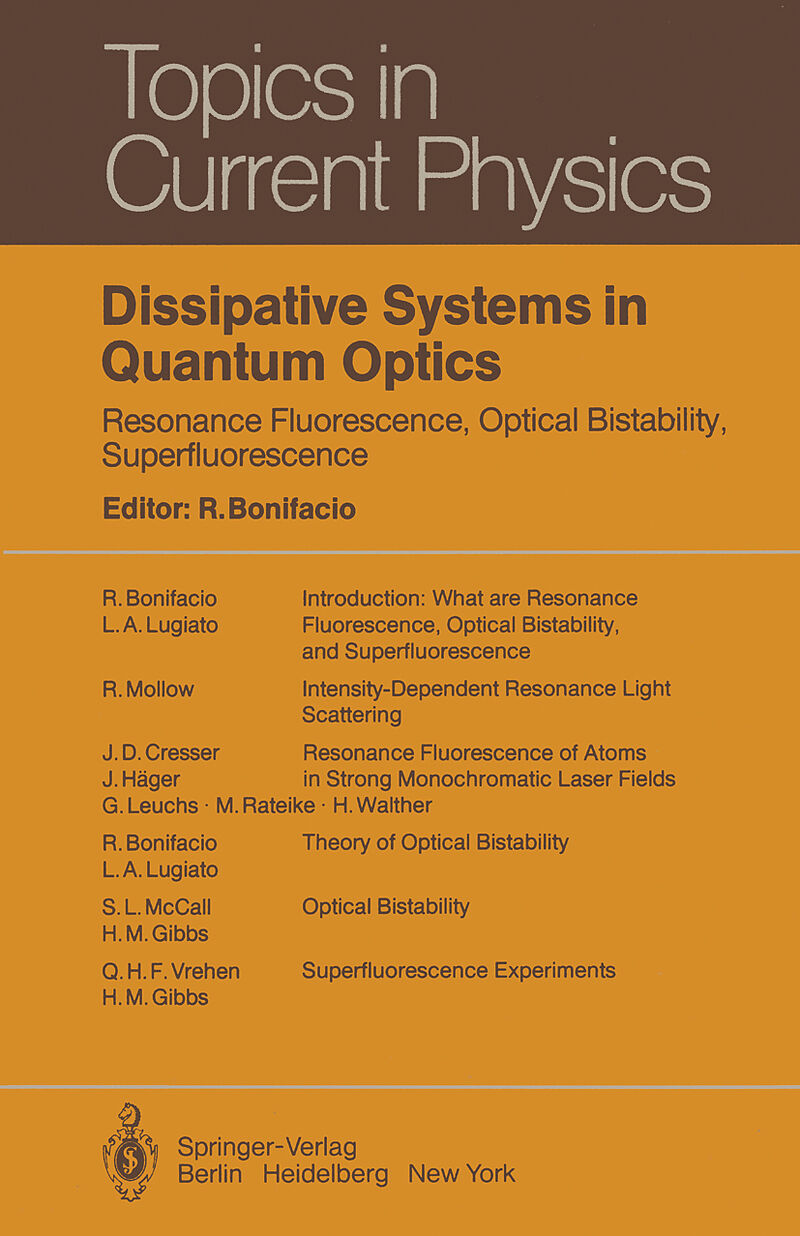Dissipative Systems in Quantum Optics
Format:
E-Book (pdf)
EAN:
9783642817175
Untertitel:
Resonance Fluorescence, Optical Bistability, Superfluorescence
Genre:
Physik, Astronomie
Herausgeber:
Springer Berlin Heidelberg
Anzahl Seiten:
154
Erscheinungsdatum:
06.12.2012
In studying the radiation-matter interaction, one can take two different approaches. The first is typical of spectroscopy: one considers the interaction between radi ation and a single atom, i. e. , one studies those phenomena in which the presence of other atoms is irrelevant. The other attitude consists, in contrast, in studying those phenomena which arise just from the simultaneous presence of many atoms. In fact, all the atoms interact with the same electromagnetic field; under suitable conditions, this situation creates strong atom-atom correlations, which in turn give rise to a cooperative behavior of the system as a whole. Cooperative means that the overall behavior is quite different from the superposition of the effects arising from single atoms and is completely unpredictable if one neglects the coup ling between the atoms induced by their common electromagnetic field. This book contains five complete and up-to-date contributions on the theory and experiments of three coherence effects in radiation-matter interaction: resonance fluorescences, optical bistability, and superfluorescence. They have raised in creasing interest in recent years from both a fundamental and an applicative view point. Even if their phenomenology appears completely different, these effects be long in the same book because they are striking examples of open systems driven far from thermal equilibrium, as those considered in Haken's synergetics and in Prigogine's theory of dissipative structures. This aspect is discussed in the in troducting chapter, in which we outline the basic physics and the essential features which unify these three effects.
Inhalt
1. Introduction: What are Resonance Fluorescence, Optical Bistability, and Superfluorescence..- 1.1 General Remarks.- 1.2 Resonance Fluorescence.- 1.3 Superfluorescence.- 1.4 Optical Bistability.- References.- 2. Intensity-Dependent Resonance Light Scattering.- 2.1 General Method of Solution.- 2.1.1 Approximations and Limiting Assumptions.- 2.1.2 Optical Bloch Equations.- 2.1.3 The Use of a c-Number Incident Field.- 2.1.4 Spectrum of Scattered Field.- 2.2 The Closed Two-Level System.- 2.2.1 Radiative Relaxation.- 2.2.2 Collisional Relaxation.- 2.2.3 General Solution for the Closed Two-Level System.- 2.3 The Open Two-Level System.- 2.3.1 Spectrum for Transitions Involving Other Levels.- 2.3.2 Effect of Atomic Decay on the Laser-Coupled Spectrum.- References.- 3. Resonance Fluorescence of Atoms in Strong Monochromatic Laser Fields.- With 28 Figures.- 3.1 Overview.- 3.2 Theoretical Treatments of Interaction of Atoms with Intense Monochromatic Fields.- 3.2.1 Simple AC Stark Effect: Spectrum.- 3.2.2 Simple AC Stark Effect: Total Scattered Intensity, Intensity Correlations, and Photon Antibunching.- 3.2.3 Variants of the AC Stark Effect.- 3.3 Experiments on the Interaction of Atoms with Intense Monochromatic Fields.- 3.3.1 Emission Spectrum.- 3.3.2 Total Emitted Intensity: Level Crossing Experiments.- a) Level Crossing Experiment.- b) Theoretical Considerations.- c) Measurements.- 3.3.3 Intensity Correlation: Photon Antibunching.- References.- 4. Theory of Optical Bistability.- 4.1 Background.- 4.2 Theory of Absorptive OB in a Ring Cavity.- 4.2.1 Semiclassical Theory.- a) Exact Treatment of the Stationary Situation.- b) Mean-Field Approach: Steady-State Analysis.- c) Mean-Field Approach: Transient Behavior.- d) Complete Linear Stability Analysis.- e) Self-Pulsing in Optical Bistability.- 4.2.2 Quantum-Statistical Theory.- a) Spectrum of Transmitted Light.- b) Photon Statistics of the Transmitted Light.- 4.3 Theory of Mixed Absorptive-Dispersive OB in a Ring Cavity.- References.- 5. Optical Bistability.- 5.1 Background.- 5.1.1 Early Work on Absorptive Optical Bistability.- 5.1.2 First Observation of Optical Bistability; Discovery of Dispersive Optical Bistability.- 5.1.3 Hybrid Optical Bistability.- 5.2 Models of Optical Bistability in a Fabry-Perot Cavity.- 5.2.1 Boundary Conditions.- 5.2.2 Nonlinear Medium.- 5.2.3 Conditions for Dispersive Bistability.- 5.3 Experimental Findings.- 5.3.1 Na Vapor.- 5.3.2 Ruby.- 5.3.3 Kerr Materials.- 5.3.4 Thermal Optical Bistability.- 5.3.5 Semiconductors.- 5.4 Future Prospects.- 5.4.1 Optical Processing and Computing.- 5.4.2 Theoretical Limits on Minimum Size.- 5.4.3 Approaching Theoretical Limits.- 5.4.4 Comparison with Other Technologies.- 5.4.5 Quantum Aspects.- 5.4.6 Preferred Wavelengths.- References.- 6. Superfluorescence Experiments.- 6.1 Background.- 6.2 Experimental Parameters.- 6.2.1 Conditions for Superfluorescence.- 6.2.2 Experimental Techniques.- 6.2.3 Survey of Experiments.- 6.2.4 Details of the Cesium Experiment.- 6.3 Single Pulses.- 6.3.1 Observations of Single Pulses in Cesium.- 6.3.2 Maxwell-Bloch Equations and Ringing.- 6.3.3 Comparison with Computer Simulations.- 6.3.4 Multiple-Pulse SF and Transverse Effects.- 6.4 The Initiation of Superfluorescence.- 6.4.1 Theory.- 6.4.2 Direct Measurement of ?0.- 6.4.3 Quantum Fluctuations.- 6.5 Sample Dimensions.- 6.5.1 Sample Length.- 6.5.2 Fresnel Number and Spatial Coherence.- 6.6 Level Degeneracies.- 6.6.1 Quantum Beats from Coupled Transitions.- 6.6.2 Beats from Independent Transitions.- 6.6.3 Polarization Effects.- 6.7 Summary.- References.

Leider konnten wir für diesen Artikel keine Preise ermitteln ...
billigbuch.ch sucht jetzt für Sie die besten Angebote ...
Die aktuellen Verkaufspreise von 3 Onlineshops werden in Realtime abgefragt.
Sie können das gewünschte Produkt anschliessend direkt beim Anbieter Ihrer Wahl bestellen.
Loading...
Die aktuellen Verkaufspreise von 3 Onlineshops werden in Realtime abgefragt.
Sie können das gewünschte Produkt anschliessend direkt beim Anbieter Ihrer Wahl bestellen.
| # | Onlineshop | Preis CHF | Versand CHF | Total CHF | ||
|---|---|---|---|---|---|---|
| 1 | Seller | 0.00 | 0.00 | 0.00 |
